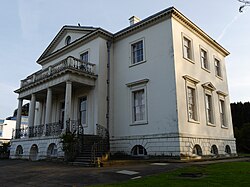Mount Clare, Roehampton
| Mount Clare | |
| Surrey | |
|---|---|
 Mount Clare | |
| Location | |
| Grid reference: | TQ21637400 |
| Location: | 51°27’7"N, 0°15’3"W |
| History | |
| Built 1772 | |
| For: | George Clive by Sir Robert Taylor |
| Country house | |
| Information | |
| Owned by: | Southlands Methodist Trust |
Mount Clare is a grand house built in 1772 in Roehampton, in Surrey. It is now on Minstead Gardens, and is a Grade I listed building.[1]
The architect was Sir Robert Taylor,[2] and the house was enlarged with a portico and other enrichments in 1780 by Placido Columbani.
The house was built for the politician George Clive[2] and the gardens were landscaped by Lancelot "Capability" Brown.[3]
Notable residents
Clive died in 1779. Subsequent residents have included:
- 1780–1804: Sir John Dick,[3] British Consul at Leghorn,[2] who died at the house on 2 December 1804[4]
- 1807–1819: the chemist Charles Hatchett FRS, who discovered the element niobium[3]
- 1830–1832: Humphrey St John-Mildmay, sixth son of the third Baronet, and Member of Parliament for Southampton[3]
- 1840–1846: Admiral of the Fleet Sir Charles Ogle, 2nd Baronet[3]
- 1874–1908: Hugh Colin Smith, Governor of the Bank of England.[3] Smith's stockbroker descendants lived in the house until 1945.[3]
Requisition in 1945 and subsequent use
The house was requisitioned by Wandsworth Borough Council in 1945. In 1963 it became a hall of residence for Garnett College, Britain's only dedicated lecturer-training college. (Garnett College later became part of Woolwich Polytechnic, then Thames Polytechnic, then the University of Greenwich.)
Today, Mount Clare is owned by the Southlands Methodist Trust[5] and used as a hall of residence for the University of Roehampton.[3]
Pictures
| ("Wikimedia Commons" has material about Mount Clare, Roehampton) |
References
- ↑ National Heritage List 1184436: Mount Clare, Minstead Gardens (Grade I listing)
- ↑ 2.0 2.1 2.2 Cherry, Bridget and Pevsner, Nikolaus (1983). The Buildings of England – London 2: South. London: Penguin Books. pp. 694–5. ISBN 0 14 0710 47 7.
- ↑ 3.0 3.1 3.2 3.3 3.4 3.5 3.6 3.7 Gerhold, Dorian (1997). Villas and Mansions of Roehampton and Putney Heath. Wandsworth Historical Society. pp. 31–33. ISBN 0 905121 05 8.
- ↑ "John Dick – British Consul at Leghorn". James Boswell.info. http://www.jamesboswell.info/biography/john-dick-british-consul-leghorn. Retrieved 16 January 2014.
- ↑ Methodist Council (2015), Southlands College and the Southlands Methodist Trust, Retrieved 28 May 2018



